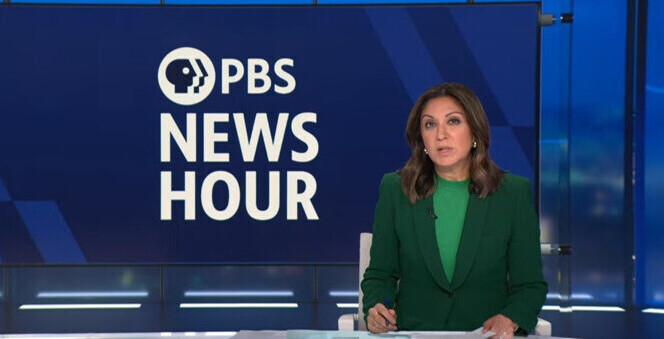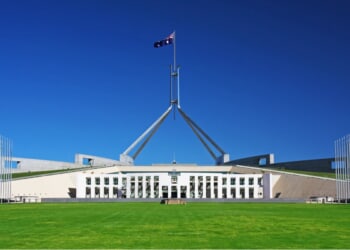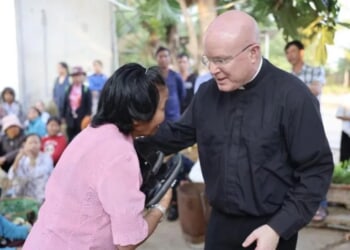Among the clips resurrected from my childhood by YouTube, none stirs what Portuguese speakers refer to as saudade as much as the signoff for Boston’s public television stations. It features stills of Julia Child, Kermit the Frog, Christopher Lydon, Zoom, and other WGBH mainstays set to Andrew Arvin’s modern baroque composition “Rondo A Go-Go.” It turns out that other public television stations, such as this one from KUON in Lincoln, Nebraska, and this one from WNPB of Morgantown, West Virginia, offered similarly powerful signoffs.
Fans of such 1980s and 1970s midnight goodbyes can dispense with the saudade and look forward to not the past but the future, as all public television stations hopefully deliver such beautiful signoffs in unison for a permanent goodbye. This joyous farewell, of course, does not mean these stations permanently go off the air but instead permanently go off the dole.
The Trump administration prepares a recissions package for Capitol Hill that includes a cut of $1.1 billion, or what the Washington Post describes as “about two years of funding,” for the Corporation for Public Broadcasting.
The revelation last year from longtime National Public Radio (NPR) reporter Uri Berliner that the outfit’s D.C. newsroom employs 87 registered Democrats and zero Republicans confirms what any non-delusional listener of NPR intuitively knew: that the broadcaster uses everyone’s tax dollars to promote an outlook embraced by a tiny sliver of the population.
Of course, such complaints of bias date back decades, if not to the origins of the Corporation for Public Broadcasting. In 1979, on PBS no less, M. Stanton Evans cited a recent program, “an hour-long commercial for Communist Cuba, which proves there are commercials on public television,” to convey his point that compulsory funding for a television channel generates propaganda.
“I don’t disagree with them having an opinion,” Evans explained. “I disagree with them making me pay for it with my tax money. Why should I pay my tax money to put Fidel Castro’s propaganda on American television?” (RELATED: Public Television and Radio Remain Unconstitutional)
In the world of hundreds of cable channels, Netflix, Roku, and Amazon Prime Video, and such clip options as TikTok and YouTube, public television seems not only immoral but passé.
We may need tax dollars to fund an army. But television thrives without state subsidy. It’s pretty popular minus government involvement. Few require coercion to watch; many require it to stop watching. Why, then, must the government coerce taxpayers to fund this one network?
During the 1970s and even into the 1980s, public television felt like the only place one could catch Monty Python’s Flying Circus or Doctor Who. And 3-2-1 Contact, at least when they played “The Bloodhound Gang,” was pretty cool. One finds multiple streaming, DVD, and broadcast options for all that now. Ditto for far-left “news.” Leftists prefer MSNBC, CNN, or any of the networks to The PBS News Hour. HBO Max now plays Sesame Street, for goodness’ sake.
Still, that immoral component eclipses its outdated quality. It glares most obviously in the liar’s way public broadcasting thanks its benefactors. This gratitude, which masks a profound ingratitude, manifests in two ways.
First, PBS or NPR may acknowledge some company or foundation that provided money for this or that program. Secondly, a voice on radio or television informs that the broadcast owes its existence “to viewers like you,” as though the periodic pledge drives pay for Antiques Roadshow or Wait, Wait … Don’t Tell Me!
Why the refusal to thank the biggest donor for public broadcasting? The taxpayer.
Public broadcasting wishes to hide the dirty little secret that, like Izvestia or Islamic Republic of Iran Broadcasting, it amounts to state media. It takes money from one of the broadest possible bases imaginable (people who pay income taxes) and distributes it to the most narrow crew possible (urban progressives). Its wealthy and white audience, more than three times as likely to self-describe as liberal and more than three times as likely to boast a graduate degree, does not need our subsidy. But this Karen demographic seems loud and entitled enough to demand it.
“What thrilling lectures on solar physics will such pictures permit!” inventor Lee de Forest predicted of television in its embryonic stages. “What could be a more fitting theme for a weekly half-hour of television than a quiet parade through some famous art gallery, pausing for a moment before each masterpiece while the gifted commentator dwells briefly upon its characteristics, explains its meaning, recounts the story of its creation, its creator?”
Probably the boosters of public broadcasting shared such hifalutin dreams for their endeavor. But just as all channels not committed to not becoming the E! channel eventually become the E! channel and all newspapers not committed to not becoming the National Enquirer eventually become the National Enquirer, public radio and television, by excluding much of the public to tailor programming to a progressive clique, became propaganda for leftists.
Hidden Brain on NPR and American Masters on PBS — even if it only got around to portraying a movement conservative last year after 39 seasons — offer idiot-box fare for non-idiots. But so much of the viewing and listening experience seems curated for people who say “Latinx” and laugh in solidarity to Hannah Gadsby’s jokes. If it’s for them and not us, then they should pay for it.
The annual, April 15 pledge drive conducted by Uncle Sam just ended — for good.
READ MORE from Daniel J. Flynn:
The People Who Came for Your Plastic Bag and Straw Now Want Your Dog
Simple Math Shows That China Lacks Leverage in This Trade War




![Jasmine Crockett Justifies Mass Illegal Immigration With Bizarre Argument [WATCH]](https://www.right2024.com/wp-content/uploads/2025/03/1742007023_Jasmine-Crockett-Justifies-Mass-Illegal-Immigration-With-Bizarre-Argument-WATCH-350x250.jpg)
![Red Sox Fan Makes the ‘Catch of the Day’ with Unconventional ‘Glove’ [WATCH]](https://www.right2024.com/wp-content/uploads/2025/04/Red-Sox-Fan-Makes-the-‘Catch-of-the-Day-with-350x250.jpg)

![NYC Tourist Helicopter Falls into Hudson River, Siemens Executive and Family Among Those Killed [WATCH]](https://www.right2024.com/wp-content/uploads/2025/04/NYC-Tourist-Helicopter-Falls-into-Hudson-River-Siemens-Executive-and-350x250.jpg)








